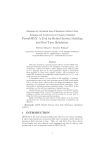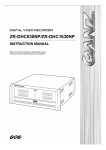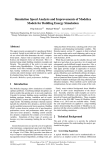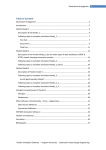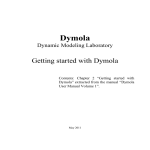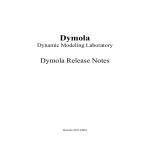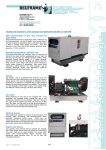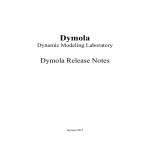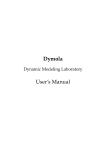Download Quantised State System Simulation in Dymola/Modelica using the
Transcript
Quantised State System Simulation in Dymola/Modelica Using the DEVS Formalism Quantised State System Simulation in Dymola/Modelica using the DEVS Formalism Tamara Beltrame VTT, Industrial Systems PO Box 1000, VM3 02150 Espoo, Finland [email protected] François E. Cellier Institute of Computational Science ETH Zurich 8092 Zurich, Switzerland [email protected] Abstract Continuous-time systems can be converted to discreteevent descriptions using the Quantised State Systems (QSS) formalism. Hence it is possible to simulate continuous-time systems using a discrete-event simulation tool, such as a simulation engine based on the DEVS formalism. A new Dymola library, ModelicaDEVS, was developed that implements the DEVS formalism. DEVS has been shown to be efficient for the simulation of systems exhibiting frequent switching operations, such as flyback converters. ModelicaDEVS contains a number of basic components that can be used to carry out DEVS simulations of physical systems. Furthermore, it is also possible - with some restrictions - to combine the two simulation types of ModelicaDEVS and Dymola (discrete-event and discretetime simulation) and create hybrid models that contain ModelicaDEVS as well as standard Dymola components. Keywords: DEVS formalism; Quantised State Systems; Event-Based Simulation; Numerical Integration 1 Introduction of the new integration approach was to replace the discretisation of time by a quantisation of state. The DEVS formalism turned out to be particularly well suited for implementing such a state quantisation approach, given that it is not limited to a finite number of system states, which is in contrast to many other discrete-event simulation techniques. The Quantised State Systems (QSS) introduced by Kofman [6] in 2001 improved the original quantised state approach of Zeigler by avoiding the problem of ever creating illegitimate models, and hence gave rise to efficient DEVS simulation of large and complex systems. The simulation of a continuous system by a (discrete) DEVS model comes with several benefits: When using discretisation of time, variables have to be updated synchronously1 . Thus, the time steps have to be chosen according to the variable that changes the fastest, otherwise a change in that variable could be missed. In a large system where probably very slow but also very fast variables are present, this is critical to computation time, since the slow variables have to be updated way too often. The DEVS formalism however allows for asynchronous variable updates, whereby the computational costs can be reduced significantly: every variable updates at its own speed; there is no need anymore for an adaptation to the fastest one in order not to miss important developments between time steps. This property could be extremely useful in stiff systems that exhibit widely spread eigenvalues, i.e., that feature mixed slow and fast variables. The DEVS formalism is very well suited for problems with frequent switching operations such as electrical Since Dymola/Modelica was primarily designed to deal with continuous physical problems, numerical integration is central to its operation, and therefore, the search for new algorithms that may improve the efficiency of simulation runs is justified. Toward the end of the nineties, a new approach for numerical integration by a discrete-event formalism has been developed by Zeigler et al. [13]: given the fact that all computer-based continuous system simulations have to undergo a discretisation of one 1 Note that this is not true for methods with dense output. Howform or another –as digital machines are not able ever, the above statement holds for the majority of today’s integrato process raw continuous signals– the basic idea tion methods, since they rarely make use of dense output. The Modelica Association 73 Modelica 2006, September 4th – 5th T. Beltrame, F.E. Cellier external event has been received. δint (s) is the internal transition that is executed as soon as the system has spent in its current state the time indicated by the time-advance function. ta(s) is the so-called time advance function that indicates how much time has to pass until the system undergoes the next internal transition. The timeadvance function is often represented by variable σ which holds the value for the amount of time that the system has to remain in its current state in the absence of external events. The λ-function is the output function. It is executed prior to performing an internal transition. External transitions do not produce output. Figure 1 illustrates the functioning of a DEVS model: the system receives input (top graph) at certain time Since the mid seventies, when Zeigler introduced the instants, changes its states according to the internal DEVS formalism [11], there have emerged several and external transitions (center graph), and produces DEVS implementations, most of them designed to output (bottom graph). simulate discrete systems. However, one simulation/modelling software system aimed at simulating continuous systems is PowerDEVS [8]: it provides a library consisting of block diagram component models that can be used for modelling any system described by ODE’s (DAE’s), thereby allowing for the simulation of continuous systems. The implementation of ModelicaDEVS has been kept close to the PowerDEVS simulation software. Hence ModelicaDEVS can be considered a re-implementation of PowerDEVS in Modelica. power systems. Given that the problem of iteration at discontinuities does not apply anymore, it even allows for real-time simulation. For hybrid systems with continuous-time, discretetime, and discrete-event parts, a discrete-event method provides a “unified simulation framework”: discretetime methods can be seen as a particular case of discrete-event methods [6], and continuous-time parts can be transformed in a straightforward manner to discrete-time/discrete-event systems. When using the QSS approach of Kofman in order to transform a continuous system into a corresponding discrete system, there exists a closed formula for the global error bound [2], which allows a mathematical analysis of the simulation. 2 Continuous with DEVS 2.1 System Simulation The DEVS Formalism Figure 1: Trajectories in a DEVS model. The DEVS formalism has been introduced by Zeigler in 1976 [11]. It was the first methodology designed for discrete-event system simulation that is based on In theory, DEVS models can describe arbitrarily system theory. complex systems. The only drawback is that the more complex the system is, the more difficult it will be A DEVS model has the following structure: to set up the correct transition functions describing the system. Fortunately, complex systems can be M = hX,Y, S, δint (s), δext (s, e, x), λ(s),ta(s)i broken down into simpler submodels that are easier to where the variables have the following meaning (see handle. The fact that DEVS is closed under coupling also [2], Chapter 11): [2] makes such an approach viable. X represents all possible inputs, Y represents the Figure 2 illustrates this concept: the model N consists outputs, and S is the set of states. of two coupled atomic models Ma and Mb . N can be The variable e indicates the amount of time the system said to wrap Ma and Mb and is indistinguishable from has already spent in the current state. δext (s, e, x) the outside from an atomic model. is the external transition that is executed after an The Modelica Association 74 Modelica 2006, September 4th – 5th Quantised State System Simulation in Dymola/Modelica Using the DEVS Formalism be the set of piecewise continuous trajectories, and let x ∈ Ω be a continuous trajectory. The mapping b : Ω → Ω is a hysteretic quantisation function if the trajectory q = b(x) satisfies: Qm if t = t0 Qk+1 if x(t) = Qk+1 ∧ q(t − ) = Qk ∧ k < r q(t) = Q if x(t) = Qk − ε ∧ q(t − ) = Qk ∧ k < 0 k−1 − q(t ) otherwise and: Figure 2: Coupled DEVS models [2]. 2.2 0 if x(t0 ) < Q0 r if x(t0 ) ≥ Qr m= j if Q j ≤ x(t0 ) < Q j+1 Quantised State Systems For a system to be representable by a DEVS model, it must exhibit an input/output behaviour that is describable by a sequence of events. In other words, the DEVS formalism is able to model any system with piecewise constant input/output trajectories, since piecewise constant trajectories can be described by events [2]. Continuous state variables are being quantised. Consider the following system represented by the statespace description: ẋ(t) = f(x(t), u(t),t) where x(t) is the state vector and u(t) is the input vector, i.e. a piecewise constant function. The corresponding quantised state system has the following form: ẋ(t) ≈ f(q(t), u(t),t) where q(t) is the (componentwise) quantised version of the original state vector x(t). A simple quantisation function could be: q(t) = floor(x(t)). Unfortunately, the transformation of a continuous system into its discrete counterpart by applying an arbitrarily chosen quantisation function can yield an illegitimate model2 . Thus, the quantisation function has to be chosen carefully, such that it prevents the system from switching states with an infinite fequency. This property can be achieved by adding hysteresis to the quantisation function [6], which leads to the notion of a Quantised State System (QSS) as introduced by Kofman [6] providing legitimate models that can be simulated by the DEVS formalism. A hysteretic quantisation function is defined as follows [2]: Let Q = {Q0 , Q1 , ..., Qr } be a set of real numbers where Qk−1 < Qk with 1 ≤ k ≤ r. Let Ω 2 Definition [2]: “A DEVS model is said to be legitimate if it cannot perform an infinite number of transitions in a finite interval of time.” Illustrative examples of illegitimate models can be found in [2] and [6]. The Modelica Association The discrete values Qi and the distance Qk+1 − Qk (usually constant) are called the quantisation levels and the quantum, respectively. The boundary values Q0 and Qr are the upper and the lower saturation values, and ε is the width of the hysteresis window. Figure 3 shows a quantisation function with uniform quantisation intervals. Figure 3: Quantisation function with hysteresis [2]. The QSS described above is a first-order approximation of the real system trajectory. Kofman however has also introduced second- and third-order approximations that may reduce the error made by the approximation. These systems are referred to as QSS2 [7] and QSS3 [9], respectively. 3 ModelicaDEVS The average block of the ModelicaDEVS library exhibits the following basic structure: 75 Modelica 2006, September 4th – 5th T. Beltrame, F.E. Cellier 1 2 3 4 5 6 7 8 9 10 11 12 13 14 15 16 17 18 19 20 21 22 23 24 25 26 27 28 29 30 31 32 33 34 by an equation block SampleBlock extends ModelicaDEVS.Interfaces. ... ; parameter Real ... ; dext = uEvent; where uEvent is the Boolean component of the connector that represents an input event. Suppose now that block A produces an output event at time t = 3. At this precise instant, it updates its output vector with the appropriate values (the coefficients of the Taylor series) and sets A.yEvent to true: protected discrete Real lastTime(start=0); discrete Real sigma(start=...); Real e; Boolean dext; Boolean dint; [...other variable declarations...] when dint yVal[1]= yVal[2]= yVal[3]= end when; yEvent = equation dext = uEvent; dint = time>=pre(lastTime)+pre(sigma); when {dint} then yVal[1]= ...; yVal[2]= ...; yVal[3]= ...; end when; yEvent = edge(dint); then ...; //new output value 1 ...; //new output value 2 ...; //new output value 3 edge(dint); Still at time t = 3, block B notices that now B.uEvent has become true (note that B.uEvent = A.yEvent because the two blocks are connected), and therefore dext has become true, also. Consequently, Block B is executing its external transition [4]. when {dint, dext} then e=time-pre(lastTime); if dint then [..internal transition behaviour..] else [..external transition behaviour..] end if; lastTime=time; end when; A DEVS model must contain code to perform internal and external transitions, as well as execute the time advance and output functions at the appropriate instants. All of these functions have to be explicitly or implicitly present in the ModelicaDEVS blocks. The time advance function is normally represented by a variable sigma. It is a popular trick in DEVS end SampleBlock; to represent the current value of the time advance function by sigma [2]. The following sections will offer more insight into the The internal transition is executed when dint is true. reasons for this specific block structure. An internal transition depends only on sigma. Hence the value of dint can be calculated as: In accordance with the PowerDEVS implemen- dint = time >= pre(lastTime) + pre(sigma); tation, ModelicaDEVS event ports (connectors) where lastTime holds the time of the last execution of consist of four variables representing the coefficients a transition (internal or external). to the first three terms (constant, linear, and quadratic) The external transition is executed when dext is true. of the function’s Taylor series expansion, and a The variable dext is defined as follows: Boolean value that indicates whether a block is dext = uEvent; currently sending an event. The internal and external transitions are represented Dense output can then be approximated as: by a when-statement. The reason for packing yout = y0 + y1 · (t − tlast ) + y2 · (t − tlast )2 the internal and external transitions into a single whereby the coefficient of the quadratic term of when-statement instead of having two separate whenthe Taylor series, y2 = yVal[3], is only used by statements, one representing the internal transition the third-order accurate method, QSS3, whereas the and the lambda function, the other one representing linear term, y1 = yVal[2], is used by QSS2 and QSS3. the external transition, is due to a rule of the Modelica language specification that states that equations in Let us now consider a small example in order to gain different when-statements may be evaluated simulincreased insight into the role of the Boolean variable taneously. Hence, if there are two when-statements of the port. Let us assume a two-block system consist- each containing an expression for a variable X, X ing of block A and block B, where the only input port is considered overdetermined. This circumstance of block B is connected to the only output port of block would cause a syntactical problem with variables that A. Every block features a variable dext accompanied have to be updated both during the internal and the The Modelica Association 76 Modelica 2006, September 4th – 5th Quantised State System Simulation in Dymola/Modelica Using the DEVS Formalism external transition and thus would have to appear in both when-statements. For this reason, we need to have a when-statement that is active if either dint or dext becomes true. Subsequently, an additional discrimination is done within the when-statement, determining whether it was an internal (dint is true) or an external transition (dext is true) that made the when-statement become active, and as the case may be, updating the variables with the appropriate value. The lambda function is executed right before an internal transition. Lines 17-22 of the “block basic structure” code (beginning of Section 3) constitute the typical lambda function part, containing a whenstatement and a separate instruction for the yEvent variable. The right hand side of the equations in the lambda function normally depends on pre() values of the used variables. This is due to the fact that the lambda function has to be executed prior to the internal transition. The variable yEvent has to be true in the exact instant when an internal transition is executed and false otherwise. This behaviour is obtained by using the Modelica edge() operator. There is one particular situation that can occur in a model that requires special attention: let us assume two connected blocks, where both block A and block B have to execute an internal transition simultaneously (Figure 4). Whereas block A simply Figure 4: Concurrent events at block B. executes its internal transition, block B is confronted with the problem of concurrent events: from block A it receives an external event, but at the same time, it was about to undergo its own internal transition. Which event should be processed first? This question is to be answered by the priority settings between the two blocks. In our simple two-block example there are only two possible priority orderings with the following consequences: either block A is prior to block B, and block A will produce the output event before block B executes the internal transition (block B will first execute an external transition triggered by the external event it received from block A), or block B is prior The Modelica Association to block A, such that block B will first undergo its internal transition and receive the external event right afterwards, when A will be allowed to execute its internal transition. The problem of block priorities can be solved in two ways: by an explicit, absolute ordering of all components in a model (e.g., a list), or by letting every block determine itself whether it processes the external or the internal event first, in case both of them occur simultaneously. ModelicaDEVS implements the latter approach. As can be seen in the “block basic structure” code, internal transitions take always priority over external transitions (line 26: the code checks first whether dint is true). The reason for this choice is quite simple. As internal events are processed before external events, and since internal events are accompanied by output events, the variable yEvent can be computed as a function of dint alone. If we were to force external events to be processed before internal events, we would need to make sure that yEvent is only set true in the case that the internal event is not accompanied by a simultaneous external event. Thus yEvent would now be a function of both dint and dext. Yet, dext is a function of uEvent. Thus, if ModelicaDEVS blocks were connected in a circular fashion, as this is often the case, an algebraic loop in discrete (Boolean) variables would be created, which would get the Dymola compiler into trouble. By forcing the internal events to always take preference over external events, ModelicaDEVS blocks can be interconnected in an arbitrary fashion without ever creating algebraic loops in the Boolean eventindication variables. Note that since Dymola/Modelica is already aimed at object-oriented modelling, which includes the reuse of multi-component models as parts of larger models, the issue of hierarchically coupled models did not require any special treatment in ModelicaDEVS. Dymola can trigger two types of events: state events that require iteration to locate the event time, and time events that make Dymola “jump” directly to the point in time when the time event takes place. The only expressions responsible for activating the when-statements in the models, namely: dext = uEvent; and: dint = time >= pre(lastTime) + pre(sigma); both trigger time events and hence avoid the computationally more expensive state events. 77 Modelica 2006, September 4th – 5th T. Beltrame, F.E. Cellier An earlier version of ModelicaDEVS used an approach that triggered mostly state events. Inspired by the book of Fritzson [4], a number of small modifications have been applied that converted all state events to time events. Performance comparisons carried out between the two versions showed that the time-event approach is roughly four times faster than an equivalent approach triggering state events. 4 Results 4.1 Efficiency In order to compare the run-time efficiency of ModelicaDEVS to other simulation software systems (PowerDEVS and standard Dymola), a system with frequent switching operations was modelled using each of the three tools (PowerDEVS, ModelicaDEVS and Dymola), and the execution times of the three codes were compared against each other. The chosen system is the flyback converter example presented in [5]. The flyback converter can be used to transform a given input voltage to a different output voltage. It belongs to the group of DC-DC converters. A very simple electrical circuit with a voltage source connected to the primary winding of the converter and a load to its secondary winding looks as shown in Figure 5. Figure 6: The flyback converter output. or PowerDEVS, the behaviour of the converter needs to be converted to a causalised block diagram3 , which then can be modelled using component models of the PowerDEVS/ModelicaDEVS libraries. Figure 7 shows the flyback converter model built in ModelicaDEVS. The structure of this block diagram is also valid for the PowerDEVS model. Figure 7: The ModelicaDEVS flyback converter. Table 1 provides the average simulation CPU time for a simulation of 0.002 seconds of the flyback converter model in standard Dymola, ModelicaDEVS, and PowerDEVS, respectively. The Dymola and ModFigure 5: The flyback converter in Dymola. elicaDEVS model were simulated setting the numerical integration method to LSODAR4 . Testing has been Figure 6 shows the first two milliseconds of a simula- carried out on an IntelCeleron 2.6 GHz Laptop with tion run of the flyback converter circuit given in Figure 256MB RAM. The resulting CPU time may vary from 3 For more details on the causalising process in the flyback con5. The rapid switching is a result of the high switching rate of the ideal switch. verter example, see [1]. 4 Although ModelicaDEVS does not make use of LSODAR diThe flyback converter is described by a set of acausal equations in Dymola. However, in order to be able to rectly, the event handling behaviour of Dymola is somewhat influmodel the flyback converter in either ModelicaDEVS enced by the selection of the numerical integration algorithm. The Modelica Association 78 Modelica 2006, September 4th – 5th Quantised State System Simulation in Dymola/Modelica Using the DEVS Formalism one computer system to another, but the relative ordering is expected to remain the same. Table 1: Execution efficiency comparison. CPU time result time [s] events points Dymola 0.062 239 738 QSS1 3.55 6363 11829 M-DEVS QSS2 0.688 958 2299 QSS3 0.656 833 2164 QSS1 0.064 N/A N/A P-DEVS QSS2 0.019 N/A N/A QSS3 0.018 N/A N/A Table 1 shows a clear ordering of the three different systems in terms of performance: PowerDEVS is faster than Dymola, which in turn is faster than ModelicaDEVS. First, it needs to be remarked that standard Dymola simulates this model very efficiently. The switching (BooleanPulse) block leads to time events only, whereas the diode should lead to state events. Yet, this is not the case. Switching at the input leads immediately to a switching of the diode as well. Since Dymola iterates after each event to determine a consistent set of initial conditions, the switching of the diode is accomplished at once without need of first triggering a state event. Second, the model is quite trivial. The execution time is almost entirely dictated by the number of time events handled. What happens in between events is harmless in comparison. Standard Dymola performs exactly one time event per switching. In contrast, ModelicaDEVS performs considerably more time events. Time events take here the role of integration steps. Figure 8 shows the constant term of the Taylor series expansion of the load voltage as a function of time for QSS1 and QSS3. QSS1 requires a new time event as soon as the constant output no longer represents the true output, whereas QSS3 requires an event only, when the second-order accurate Taylor series expansion no longer approximates the true output. QSS1 requires roughly eight times as many events as QSS3, and is therefore between five and six times slower. Yet, even QSS3 requires roughly three times as many events as standard Dymola. In addition, the ModelicaDEVS model contains roughly three times as many variables as the standard Dymola model. All of these variables are being stored at every event. Consequently, QSS3 is roughly nine times slower than standard Dymola. The Modelica Association Figure 8: QSS3 simulation vs. QSS1 simulation. Yet, QSS3 in PowerDEVS is roughly three times faster than standard Dymola for comparable accuracy. A comparison between PowerDEVS and ModelicaDEVS is not straightforward. PowerDEVS implements Zeigler’s hierarchical simulator [12], whereas ModelicaDEVS operates on simultaneous equations and synchronous information flow [10]. Consequently, PowerDEVS suffers from requiring message passing to implement the communication between blocks, but enjoys the advantage of only having to process those equations that are directly involved with the event being handled. In contrast, ModelicaDEVS needs to visit all equations of all blocks whenever an event takes place. Which variables are to be updated in each case is decided by Boolean expressions associated with the various when-statements. Yet the true difference in speed has probably more to do with the event handling itself. Dymola has been designed for optimal speed in the simulation of continuous models and for optimal robustness in handling hybrid models. The algorithms implemented in Dymola for robust event handling are important in the context of hybrid modelling. In the context of a pure discrete-event simulation, these algorithms are an overkill. For example, in a pure discrete-event simulation there is no need for iteration after each event to determine a new consistent set of initial conditions. In Dymola, many variables are being stored internally in order to allow LSODAR to integrate continuous state equations correctly across discontinuities. In a pure discrete-event simulation, variables need to be stored for output only. 79 Modelica 2006, September 4th – 5th T. Beltrame, F.E. Cellier 4.2 Mixed Systems du=der(u); Mixed systems contain both Dymola and Modelica blocks. Figure 9 shows an example of a simple electrical circuit modelled in Dymola, and in a mixed version with a ModelicaDEVS capacitor. Figure 10 illus- Figure 9: Two versions (Dymola and Dymola/ModelicaDEVS) of a simple electrical circuit. trates the implementation of the ModelicaDEVS capacitor. On its outside, this block looks like a normal electrical Dymola component, but internally it consists of ModelicaDEVS blocks that model the behaviour of a capacitor: The Gain block multiplies the incoming signal by the value of C1 , where C is specified by a parameter, and passes it on to the Interpolator. Taken as a whole, the ModelicaDEVS blocks constitute nothingR more than the well known capacitor formula v = C1 i dt. when sample(start,period) then yVal[1]=u; yVal[2]=if method>1 then du else 0; yVal[3]=if method>2 then der(du) else 0; end when; Given that the input of the SamplerTime block depends algebraically on the output of the Interpolator in the DEVS capacitor, Dymola would have to differentiate discrete variables, which it is unable to do. An attempt to solve this problem was made using Dymola’s “User specified Derivatives” feature described in the Dymola User’s Manual [3]: functions for the first and second derivatives have been inserted into the Interpolator, but due to unknown reasons, this did not resolve the issue either. In order to be able to perform mixed simulations nonetheless, another trick has been applied: supplementary to the standard ModelicaDEVS SamplerTime block that uses the Modelica der() operator, an additional block has been programmed: the SamplerTimeNumerical block avoids the problem caused by the der() operator by means of the delay() function that is used to differentiate the input variable numerically. Instead of the first and second derivatives of the input signal, the SamplerTimeNumerical returns a numerical approximation: Du = delay(pre(u),D); D2u= delay(pre(u),2*D); yVal[1]= pre(u); yVal[2]= if method>1 then (pre(u)-Du)/D else 0; yVal[3]= if method>2 then (pre(u)-2*Du+D2u)/(D*D) else 0; Figure 10: The internal structure of the ModelicaDEVS capacitor. Unfortunately, it is not as straightforward as it may seem at first glance to replace a component from the Dymola standard electrical library by its ModelicaDEVS equivalent: since the electrical components do not assume a certain data flow direction (they are described by acausal equations), whereas the ModelicaDEVS components do (DEVS components feature input and output ports), the ModelicaDEVS capacitor must turn acausal equations into causal ones. It assumes the capacitive current i to be given, and hence computes the capacitive voltage v. Note that such a capacitor would not work anymore correctly if we were to connect it to a voltage source instead of a current source. An even more severe problem is caused by the SamplerTime block applying the der() operator to the signal that it receives through its input port: The Modelica Association Using the new sampler block, the mixed simulation could be carried out without any problems, and the results differ only slightly from the simulation with conventional Dymola components (see Figure 11). 4.3 Hybrid Systems Hybrid systems contain mixed integration methods: standard Modelica integrators and ModelicaDEVS Integrator blocks. An example of a hybrid system is for instance an electrical circuit with at least one ModelicaDEVS capacitor/inductor (using the ModelicaDEVS Integrator block) and at least one Dymola capacitor/inductor (using the Modelica der() operator). The flyback converter of Section 4.1, where the capacitor in the secondary winding is replaced by an equivalent ModelicaDEVS capacitor, may serve as an 80 Modelica 2006, September 4th – 5th Quantised State System Simulation in Dymola/Modelica Using the DEVS Formalism 5 Conclusions A new Dymola/Modelica library implementing a number of Quantised State System (QSS) simulation algorithms has been presented. ModelicaDEVS duplicates the capabilities of PowerDEVS. The graphical user interfaces of both tools are practically identical. However, the underlying simulators are very different. Whereas PowerDEVS implements Zeigler’s hierarchical DEVS simulator, ModelicaDEVS operates on simultaneous equations and synchronous information flows. The embedding of ModelicaDEVS within the DyFigure 11: Standard Dymola (blue) and mixed (red) mola/Modelica environment enables users to mix simulation of the simple electrical circuit (Figure 9). DEVS models with other modelling methodologies that are supported by Dymola and for which Dymola offers software libraries. example of a hybrid system. Unfortunately, ModelicaDEVS is much less efficient Note that the ModelicaDEVS capacitor applies numerin run-time performance than PowerDEVS. The loss ical differentiation in order not to obtain “DAE index of run-time efficiency is probably caused by Dymola’s reduction” error messages (see previous section). event handling algorithms that have been designed for optimal robustness in the context of hybrid system simulation rather than run-time efficiency in the context of pure discrete-event system simulation. Although ModelicaDEVS offers a full implementation of a DEVS kernel and can therefore be used for the simulation of arbitrary discrete-event systems, the modelling blocks that have been made available so far in ModelicaDEVS are geared towards the simulation of continuous systems using QSS algorithms. References Figure 12: Standard Dymola (blue) and mixed (red) simulation of the flyback converter. Figure 12 shows the output of the mixed simulation compared to the result of the standard Dymola simulation. Just as it was the case with the simpler example of Section 4.2, the output of the hybrid simulation differs only slightly from the Dymola simulation. Thus, it is also possible to perform not only accurate5 mixed simulations, but also hybrid simulations. 5 Note that due to the numerical differentiation used in the Sam- plerTimeNumerical block, the result is not as accurate as if analytical differentiation had been used. However, the accuracy is sufficient for most purposes, and also adjustable through selection of the width parameter, D. The Modelica Association 81 [1] Beltrame, T. (2006), Design and Development of a Dymola/Modelica Library for Discrete Eventoriented Systems using DEVS Methodology, MS Thesis, Institute of Computational Science, ETH Zurich, Switzerland. [2] Cellier, F.E. and E. Kofman (2006), Continuous System Simulation, Springer-Verlag, New York. [3] Dynasim AB (2006), Dymola Users’ Manual, Version 6.0, Lund, Sweden. [4] Fritzson, P. (2004), Principles of ObjectOriented Modeling and Simulation with Modelica 2.1, Wiley-Interscience, New York. [5] Glaser, J.S., F.E. Cellier, and A.F. Witulski (1995), “Object-Oriented Switching Power ConModelica 2006, September 4th – 5th T. Beltrame, F.E. Cellier verter Modeling Using Dymola With EventHandling,” Proc. OOS’95, SCS Object-Oriented Simulation Conference, Las Vegas, NV, pp.141146. Biographies Tamara Beltrame received her MS degree in computer science from the Swiss Federal Institute of Technology (ETH) Zurich in 2006. She recently started working at VTT (Finland), where she deals with problems of simulation aided automation testing. [6] Kofman, E. and S. Junco (2001), “Quantised State Systems: A DEVS Approach for Continuous Systems Simulation,” Transactions of SCS, 18(3), pp.123-132. [7] Kofman, E., “A Second Order Approximation for DEVS Simulation of Continuous Systems,” Simulation, 78(2), pp.76-89. [8] Kofman, E., M. Lapadula, and E. Pagliero (2003), PowerDEVS: A DEVS-based Environment for Hybrid System Modeling and Simulation, Technical Report LSD0306, LSD, Universidad Nacional de Rosario, Argentina. [9] Kofman, E., “A Third Order Discrete Event Method for Continuous System Simulation,” Latin American Applied Research, 36(2), pp.101-108. [10] Otter, M., H. Emqvist, and S.E. Mattsson (1999), “Hybrid Modeling in Modelica Based on the Synchronous Data Flow Principle,” CACSD’99, IEEE Symposium on Computer-Aided Control System Design, Hawaii, pp.151-157. [11] Zeigler, B.P. (1976), Theory of Modeling and Simulation, John Wiley & Sons, New York. [12] Zeigler, B.P. (1984), Multifacetted Modelling and Discrete Event Simulation, Academic Press, London. [13] Zeigler, B.P. and J.S. Lee (1998), “Theory of Quantized Systems: Formal Basis for DEVS/HLA Distributed Simulation Environment,” SPIE Proceedings, Vol. 3369, pp.49-58. The Modelica Association François E. Cellier received his BS degree in electrical engineering in 1972, his MS degree in automatic control in 1973, and his PhD degree in technical sciences in 1979, all from the Swiss Federal Institute of Technology (ETH) Zurich. Dr. Cellier worked at the University of Arizona as professor of Electrical and Computer Engineering from 1984 until 2005. He recently returned to his home country of Switzerland. Dr. Cellier’s main scientific interests concern modeling and simulation methodologies, and the design of advanced software systems for simulation, computer aided modeling, and computer-aided design. Dr. Cellier has authored or coauthored more than 200 technical publications, and he has edited several books. He published a textbook on Continuous System Modeling in 1991 and a second textbook on Continuous System Simulation in 2006, both with Springer-Verlag, New York. He served as general chair or program chair of many international conferences, and serves currently as president of the Society for Modeling and Simulation International. 82 Modelica 2006, September 4th – 5th










